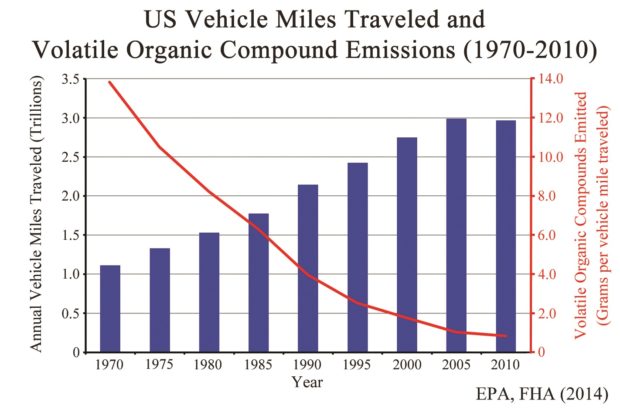On January 1, California initiated the down of legalized recreational marijuana use. That same day, a new California law regulating particle emissions from leaf blowers and lawn mowers went into effect. But cannabis users inhale thousands of times more small particles from smoking than they breathe in from outdoor air.
On November 8, 2016, California voters passed Proposition 64, ![]() legalizing the recreational use of marijuana for adults. Sale and taxation of recreational marijuana began January 1, 2018. California’s cannabis market is expected to soar to over $5 billion by 2020.
legalizing the recreational use of marijuana for adults. Sale and taxation of recreational marijuana began January 1, 2018. California’s cannabis market is expected to soar to over $5 billion by 2020.
While California encourages the inhalation of small particles from marijuana smoke, the state continues a questionable war against small particles emitted by vehicles and industry. Mary Nichols, Chairwoman of the California Air Resources Board (CARB), calls small particle pollution from trucks “toxic diesel exhaust.”
Particulate matter, or small particles, refers to PM2.5, classified by the EPA as particles smaller than 2.5 microns in diameter, much smaller than the eye can see. Particle pollution is a mixture of dust, nitrates and sulfates, metals, pollen, and organic chemicals. Small particles enter the lungs by breathing air containing particles emitted from industry and vehicles, but also from nature, such as pollen, as well as smoke from forest fires and tobacco or marijuana smoking.
Are airborne small particles harmful? Both the Environmental Protection Agency (EPA) and CARB have claimed that inhalation of small particles can cause premature death. A 2014 CARB fact sheet states:
“Long-term exposure to elevated levels of PM2.5 is associated with premature death in older adults with heart or lung diseases…Short-term exposures to elevated levels of PM2.5 also have been linked to premature death…”
CARB and EPA assert that the persons who breathe in small particles from outdoor air can die within a few hours of inhalation. But many studies find no association between small particle pollution in US ambient air and mortality.
As a result of health concerns, the California Air Resources Board has waged a war on small particles and other pollutants since 1967. Air quality standards for particles were established and updated in 1969, 1983, and 2002. The 2002 California standard for PM2.5 set a very low annual average of 12 micrograms of particles per cubic meter of ambient air. At that level, a person would inhale less than a teaspoonful of small particles over an 80-year lifetime.
The great news for US citizens is that our air ranks with the cleanest of any nation. The 1970 days of smog in Los Angeles, Cleveland, and Gary, Indiana are long gone. An example of improvement is the reduction in volatile organic compounds (VOC), one component of small particles, emitted by our vehicles. According to EPA data, vehicular VOC emissions are down more than 95 percent since 1970. The amount of small particles in our air is now so low that new regulations will have a negligible effect on the particles which people inhale.

VOC and Vehicle Mileage Graph. Courtesy of and created by Steve Goreham
Smoking one marijuana cigarette exposes the inhaler to up to 160,000 micrograms of small particles, about four times the amount from a tobacco cigarette. A single joint delivers more small particles than breathing typical California ambient air for two years. Will California marijuana smokers be dropping from “short-term premature death” as feared by CARB?
In 2017, California experienced some of the worst forest fires in history. In just two days in October, Napa Valley fires produced about 10,000 tons of PM2.5, about the amount that 35 million California vehicles produce in a year.
Today’s low level of particle emissions from trucks and leaf blowers pales when compared to particles inhaled from smoking and natural factors such as forest fires. Are efforts to reduce small particle emissions still needed?
This article originally appeared in The Daily Caller

Marijuana is a psychoactive drug–we don’t need more psychoactive substances legalized. Marijuana is a toxic substance with strong evidence that it permanently affects the brain.
People say that it is safe–how do they know that? If you were going to fly on an airliner, would you want your pilots smoking marijuana? It is also false that marijuana is needed to treat medical conditions.
If marijuana is so innocuous, then why do people even bother smoking it? Answer: Because they like getting high. The world has enough drunks and drug addicts causing megaproblems for society.
My brother works for a drug rehab charity in UK. He tells me that there has been a huge increase in people presenting with cannabis psychosis in recent years
While CARB wants to restrict VOC’s they say nothing, nothing about the worlds best air filter. The rain, sleet, snows and much more cleans our life support system called the environment. No studies have been produced to show what makes up rain drops, snow flakes (pun 1/2 intended!) or in the clouds above us. For one thing we can see without scientific devices is the glacial movements as they approach the seas and break off to turn into icebergs is the dirty lines at multiple depts. So where is the studies? How many years of participate build up is in those glaciers?
Where are the studies? I see a conspiracy here.